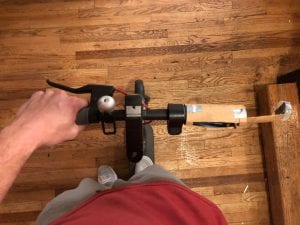Design 1: Pop-out Turn Signal
This design would be modularly integrated to the scooter by attaching a cap to both ends of the handle bars. Therefore, two identical devices would be needed (one on each side). Shown in the following images, the brown section is the original scooter handle bar, and the gray section is the cap that would secure to the end. The gray end cap has a button the rider would press to activate the turn signal extension (via an internal spring).
Design 2: Tape measure inspired Turn Signal
This prototype was designed from the inspiration of the mechanism inside a tape measure that allows it to instantly recoil. On the end cap of the handle bar, the rider would pull the switch and the section of the cap would partially extend and allow a stiff LED strip to unroll vertically. This would provide more LED surface area for other vehicles, riders, and pedestrians to see and safely acknowledge the turn. Then, the switch would be activated again to recoil the LED turn signal strip.
Design 3: Swinging lever action Turn Signal
This prototype was inspired by the trafficators found on pre-1960 Volkswagen Beetles and other vehicles that used a swinging “flag” system to indicate turning. The turn signal assembly itself would be strapped onto the handle bar, which allows it to accommodate the different sizes and shapes of handle bars on scooters and bicycles from different manufacturers. The swinging action of the lever turn signal could be actuated by either an electrical system or by a cable system. With the press of a button, a motor attached to the end point of the lever could turn the signal outwards and would flash the LED lights to indicate turning. A cable system could also accomplish the swinging action, and once fully extended it could complete a circuit which would also activate the LED lights. Pressing the button or unlocking the cable system would swing the lever back at the end of the turn.
Design 4: Slide out Turn Signal
This design was inspired by a retractable switchblade where the blade slides out for use and back in when not in use. The turn signal would attach to the handlebars of the E-scooter by sliding the entire assembly onto the handlebar. The flashing light would be powered by a small battery which would be enclosed with the light itself (bottle cap in ALL photos below). To use, the user would slide out whichever side he/she is turning with their finger. The signal will begin flashing when the user pushes the slide into the locking position (see second photo). To retract, the user will slightly push down to disengage the locking mechanism and then slide the turn signal back into its original space. The third photo shows the clearance from the user so that vehicles behind the scooter can see the turn signal.
Also, this single design is compatible for both the left and right handlebars which will decrease design time and manufacturing cost.
Design 5: Foot Pedal
This design was inspired by a foot-controlled trash canister. To activate, the user will press down on the pedal (small horizontal lever in first photo). After pressing down, the turn signal will move to the vertical position seen in the second and third photos. This prototype is actuated by a 4-bar linkage that connects the pedal with the turn signal.
Design 6: Front Panel Turn Signal
This design has the base seen in the first picture, and the turn signal panels seen in the third picture. The base will be a snap-on base that fits securely around the front pole of the scooter. The sides of the base extend up and out, so that the buttons that activate the turn signals are right next to the acceleration and brake controls of the scooter. They will also be designed to be at the same height (handlebar height). When one of the buttons is pressed, the turn signal will swing up from in front of the scooter. This turn signal will have a series of blinking lights extending out, and the furthest most light will blink like an actual turn signal. Press the button again, and the turn signal will fall back into place. The mechanics behind the activation of the turn signals have not been thought of just yet, but early ideas would be to have a motor activate both, or be spring loaded. As of now, this design would only work on E-scooters, and would have to be flipped around for designs that have the battery housing on the front pole of the scooter (Bird).
Design 7: Sub-handlebar Extender Turn Signal
This turn signal was inspired by the thought of having something very modular and small. How this design works is the top piece would snap around the handlebar and fit secure and tight. This could be the handlebar of any electric vehicle (bikes, scooters, mopeds, etc). It would have a button on the housing to extend and collapse the turn signal, that would be housed in the lower box. The ping pong ball represents the actual turn signal, while the straw represents the collapsible extender. This would extend and collapse much like a pointing stick some teachers use. It would collapse completely, and all be able to fit into the lower housing when not in use. The turn signal would also be sure to extend sufficiently enough so that any vehicle approaching from in front or behind would be able to see it clearly.


















